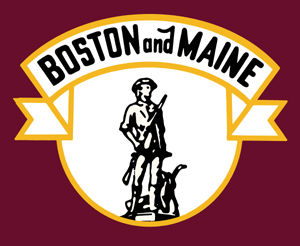
The Boston and Maine Railroad was a U.S. Class I railroad in northern New England. Originally chartered in 1835, it became part of what was the Pan Am Railways network in 1983.

The MBTA Commuter Rail system serves as the commuter rail arm of the Massachusetts Bay Transportation Authority's (MBTA's) transportation coverage of Greater Boston in the United States. Trains run over 394 mi (634 km) of track to 134 stations. It is operated under contract by Keolis, which took over operations on July 1, 2014, from the Massachusetts Bay Commuter Railroad Company (MBCR).
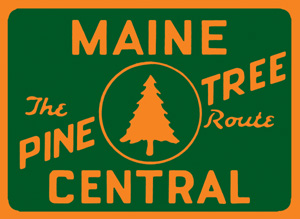
The Maine Central Railroad was a U. S. class 1 railroad in central and southern Maine. It was chartered in 1856 and began operations in 1862. By 1884, Maine Central was the longest railroad in New England. Maine Central had expanded to 1,358 miles (2,185 km) when the United States Railroad Administration assumed control in 1917. The main line extended from South Portland, Maine, east to the Canada–United States border with New Brunswick, and a Mountain Division extended west from Portland to St. Johnsbury, Vermont, and north into Quebec. The main line was double track from South Portland to Royal Junction, where it split into a "lower road" through Brunswick and Augusta and a "back road" through Lewiston, which converged at Waterville into single track to Bangor and points east. Branch lines served the industrial center of Rumford, a resort hotel on Moosehead Lake and coastal communities from Bath to Eastport.

The Providence and Worcester Railroad is a Class II railroad operating 612 miles (985 km) of tracks in Rhode Island, Massachusetts, and Connecticut, as well as New York via trackage rights. The company was founded in 1844 to build a railroad between Providence, Rhode Island, and Worcester, Massachusetts, and ran its first trains in 1847. A successful railroad, the P&W subsequently expanded with a branch to East Providence, Rhode Island, and for a time leased two small Massachusetts railroads. Originally a single track, its busy mainline was double-tracked after a fatal 1853 collision in Valley Falls, Rhode Island.

The Grafton and Upton Railroad is a Class III short line railroad in east-central Massachusetts. This 24.85 mile line runs from Grafton to Franklin and connects to CSX Transportation lines at both ends. Following a period of decline and neglect, maintenance and repairs began in 2008 with the aim of returning the line to operable condition.

The Boston and Albany Railroad was a railroad connecting Boston, Massachusetts to Albany, New York, later becoming part of the New York Central Railroad system, Conrail, and CSX Transportation. The line is currently used by CSX for freight. Passenger service is provided on the line by Amtrak, as part of their Lake Shore Limited service, and by the MBTA Commuter Rail system, which owns the section east of Worcester and operates it as its Framingham/Worcester Line.

The New York and New England Railroad (NY&NE) was a railroad connecting southern New York State with Hartford, Connecticut; Providence, Rhode Island; and Boston, Massachusetts. It operated under that name from 1873 to 1893. Prior to 1873 it was known as the Boston, Hartford and Erie Railroad, which had been formed from several smaller railroads that dated back to 1846. After a bankruptcy in 1893, the NY&NE was reorganized and briefly operated as the New England Railroad before being leased to the competing New York, New Haven and Hartford Railroad in 1898.

The Housatonic Railroad is a Class III railroad operating in southwestern New England and eastern New York. It was chartered in 1983 to operate a short section of ex-New York, New Haven and Hartford Railroad in northwestern Connecticut, and has since expanded north and south, as well as west into New York State.

The Franklin Line, also called the Franklin/Foxboro Line, is part of the MBTA Commuter Rail system. It runs from Boston's South Station in a southwesterly direction toward Franklin, Massachusetts, utilizing the Northeast Corridor before splitting off onto the namesake Franklin Branch. Most Franklin Line trains connect to the Providence/Stoughton Line at Readville, though some weekday trains use the Dorchester Branch to access South Station. Most weekday trains, and all weekend trains, bypass Hyde Park.

The East Junction Branch is a historic railroad line owned and operated by the Providence and Worcester Railroad in the U.S. state of Rhode Island and by the Massachusetts Bay Transportation Authority in Massachusetts. The line runs from the P&W's East Providence Branch in East Providence, Rhode Island, northeast to Amtrak's Shore Line at East Junction in Attleboro, Massachusetts, along a former New York, New Haven and Hartford Railroad line. In Massachusetts, CSX Transportation operates local freight service via trackage rights, which it also has on the Shore Line north towards Boston. The Massachusetts Coastal Railroad and the MBTA commuter rail have operating rights in Massachusetts; however, neither have ever run trains on the branch.

Franklin/Dean College is an MBTA Commuter Rail station located in Franklin, Massachusetts near Dean College. It serves the Franklin Line, for which it was the terminus from 1966 to 1988. The station has a mid-sized park and ride lot to serve town residents; Forge Park/495 station is intended to serve commuters from other nearby towns. The 1912-built station building still serves as a waiting hall and café, open during morning commute hours on weekdays. Franklin/Dean College station has a single side platform serving the line's single track; it is not accessible.
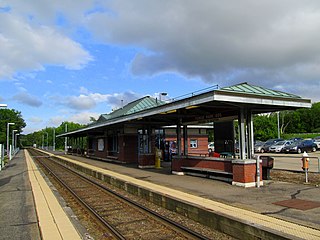
Forge Park/495 station is a Massachusetts Bay Transportation Authority (MBTA) commuter rail station on the Franklin Line located off Route 140 near Interstate 495 in Franklin, Massachusetts, United States. A park and ride station serving southwestern Boston suburbs and northeastern Rhode Island, it is the outer terminus of the Franklin Line. The station has two side platforms serving a single track, with an accessible mini-high platform and a station building on the south platform.

Bellingham Square station is a Massachusetts Bay Transportation Authority (MBTA) Silver Line bus rapid transit (BRT) station located near Bellingham Square slightly north of downtown Chelsea, Massachusetts. The station has two accessible side platforms for buses on the SL3 route. The Boston and Maine Railroad and predecessor Eastern Railroad served Chelsea station at the same location from the mid-1850s to 1958. The MBTA opened Chelsea station on the Newburyport/Rockport Line in 1985. Prior to its 2010 cancellation, the Urban Ring Project planned for a circumferential BRT line with a stop at Mystic Mall. Planning continued for the Chelsea segment; a Silver Line extension to Mystic Mall was announced in 2013. Construction began in 2015, and SL3 service to the renamed Bellingham Square station began on April 21, 2018. Commuter rail service moved to the newly constructed Chelsea station on November 15, 2021.

The Boston, Clinton, Fitchburg and New Bedford Railroad was a railroad in Massachusetts. It was formed on June 1, 1876, when the Boston, Clinton and Fitchburg Railroad merged with the New Bedford Railroad. The Boston, Clinton and Fitchburg Railroad connected with the key railroad hubs of Worcester, Framingham, and Ayer, as well as several important industrial towns such as Fitchburg and Lowell, with the latter coming through a lease of the Framingham and Lowell Railroad. The New Bedford Railroad linked Framingham with New Bedford, which was a key deep-water port.
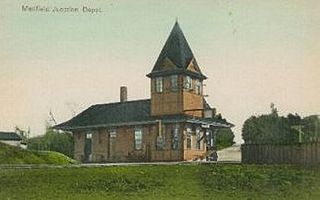
Medfield Junction is a railway junction and former train station located in northwest Medfield, Massachusetts. It is the junction of the Framingham Secondary and the former Millis Branch. The station was open from November 1861 until April 1967.
The Dighton and Somerset Railroad, currently referred to as the Dean Street Industrial Track, is a railroad that ran between Fall River and Braintree, Massachusetts. It opened in 1866; from the 1890s to the 1930s and again in the late 1950s, it was the primary rail route from Boston to the South Coast. Passenger service ended in stages with the final regular service in 1958, though freight service on two short segments continues into the 21st century. MBTA Commuter Rail service is proposed to be extended onto the northern part of the line around 2030 as part of the South Coast Rail project.
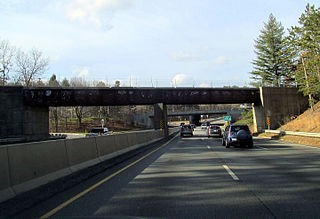
The Fitchburg and Worcester Railroad was a railroad in Massachusetts. It was incorporated in 1840 to provide a rail connection between Fitchburg and Worcester. Service began on February 11, 1850, running 18 miles from Fitchburg through Leominster and Sterling to Sterling Junction, where it connected with the Worcester and Nashua Railroad.
The Charles River Railroad was a railroad in Massachusetts. It ran from a connection with the end of the Charles River Branch Railroad in Dover to Bellingham through the current-day towns of Medfield, Millis, and Medway.
The Woonsocket Union Railroad was a railroad in Rhode Island. It was incorporated in Rhode Island in 1850 to build a rail line from the Massachusetts state line near Woonsocket through the towns of Smithfield, Burrillville, and Glocester to the Connecticut state line.

The Millis Branch was a branch of what is now the MBTA Commuter Rail system. Branching off the still-operating Needham Line at Needham Junction, it ran through the towns of Dover, Medfield, Millis, and Medway. Due to lack of subsidies and poor ridership, the line was cut back to Millis station in April 1966, and all service ended on April 21, 1967.




















